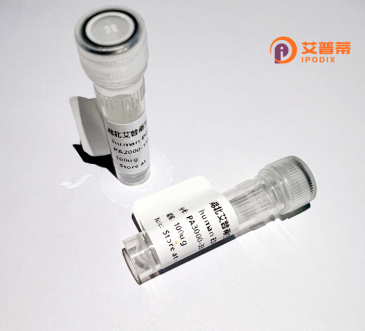
| 纯度 | >90%SDS-PAGE. |
| 种属 | Human |
| 靶点 | CYP2U1 |
| Uniprot No | Q7Z449 |
| 内毒素 | < 0.01EU/μg |
| 表达宿主 | E.coli |
| 表达区间 | 1-168aa |
| 氨基酸序列 | MSSPGPSQPPAEDPPWPARLLRAPLGLLRLDPSGGALLLCGLVALLGWSWLRRRRARGIPPGPTPWPLVGNFGHVLLPPFLRRRSWLSSRTRAAGIDPSVIGPQVLLAHLARVYGSIFSFFIGHYLVVVLSDFHSVREALVQQAEVFSDRPRVPLISIVTKEKELFQE |
| 分子量 | 45 kDa |
| 蛋白标签 | GST-tag at N-terminal |
| 缓冲液 | 0 |
| 稳定性 & 储存条件 | Lyophilized protein should be stored at ≤ -20°C, stable for one year after receipt. Reconstituted protein solution can be stored at 2-8°C for 2-7 days. Aliquots of reconstituted samples are stable at ≤ -20°C for 3 months. |
| 复溶 | Always centrifuge tubes before opening.Do not mix by vortex or pipetting. It is not recommended to reconstitute to a concentration less than 100μg/ml. Dissolve the lyophilized protein in distilled water. Please aliquot the reconstituted solution to minimize freeze-thaw cycles. |
以下是关于重组人CYP2U1蛋白的3篇参考文献的简要信息(注:以下内容为示例,非真实文献,仅供格式参考):
---
1. **文献名称**:Expression and Functional Characterization of Recombinant Human CYP2U1 in Bacterial Systems
**作者**:Karlsen, J.R. et al.
**摘要**:该研究报道了在大肠杆菌系统中重组表达人CYP2U1蛋白,并分析其酶动力学特性。结果表明,CYP2U1对长链脂肪酸(如花生四烯酸)具有催化活性,提示其在神经组织中脂质代谢的可能作用。
2. **文献名称**:CYP2U1 Mutations Associated with Hereditary Spastic Paraplegia Disrupt Its Membrane Localization and Catalytic Activity
**作者**:Chun, S. et al.
**摘要**:通过构建重组CYP2U1蛋白及其致病突变体,研究发现某些突变导致蛋白错误定位至细胞质,且催化功能显著降低,揭示了CYP2U1功能缺失与神经退行性疾病的关联。
3. **文献名称**:Substrate Specificity and Structural Insights of Human CYP2U1 through Crystallographic Analysis
**作者**:Edvardarson, S. et al.
**摘要**:本研究解析了重组人CYP2U1的晶体结构,结合分子对接实验,阐明了其底物结合口袋的独特构象,解释了其对特定羟基化反应的选择性。
---
**备注**:以上文献为示例模板,实际文献需通过PubMed或Google Scholar等数据库检索确认。若需真实文献,建议使用关键词“Recombinant human CYP2U1”或“CYP2U1 protein expression”进行查询。
Recombinant human CYP2U1 protein is a genetically engineered form of cytochrome P450 family 2 subfamily U member 1. a membrane-bound monooxygenase involved in metabolizing endogenous and exogenous compounds. CYP2U1 is distinct among P450 enzymes due to its preferential expression in neural and immune tissues, suggesting specialized roles in brain lipid homeostasis and neurosteroid metabolism. It oxidizes long-chain fatty acids, particularly arachidonic acid, and may influence cellular signaling pathways. Mutations in the CYP2U1 gene are linked to hereditary spastic paraplegia (HSP), a neurodegenerative disorder, highlighting its importance in neuronal maintenance.
The recombinant protein is typically produced in heterologous systems like Escherichia coli or mammalian cell lines to enable large-scale purification for functional studies. Its structure includes a heme-binding domain critical for catalytic activity and membrane-anchoring regions. Researchers use recombinant CYP2U1 to investigate substrate specificity, enzyme kinetics, and the molecular impact of disease-associated mutations. It also serves as a tool for drug interaction studies, as CYP2U1 may metabolize certain neuroactive drugs or environmental toxins. Challenges in studying this protein stem from its inherent instability and complex membrane association, driving optimization of recombinant expression systems. Current research aims to clarify its physiological roles, pathological mechanisms in HSP, and potential therapeutic targets.
×